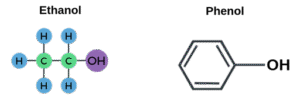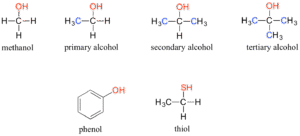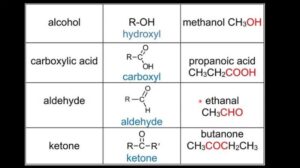Back to: Organic Chemistry 100 Level
Welcome to class!
Hello my champion! I’m so happy to have you here once again. You’re showing amazing consistency, and that’s exactly what great scientists do—keep learning and growing! Today’s topic is super exciting and practical because it’s about substances you’ve definitely seen or even used in real life. Let’s learn about Alcohols and Phenols, two important members of the functional group family in Organic Chemistry.
Functional Groups I: Alcohols And Phenols
What Are Functional Groups?
Before we zoom into alcohols and phenols, let’s remind ourselves what a functional group is. A functional group is the special part of an organic compound that determines how that compound behaves or reacts. It’s like the “active zone” of the molecule.

Now, let’s focus on two important types: Alcohols and Phenols.
Alcohols
Alcohols are organic compounds that contain the –OH group, also known as the hydroxyl group, attached to a saturated carbon atom (that is, a carbon joined by single bonds only).
General formula: R–OH, where R is an alkyl group (like CH₃, C₂H₅, etc.)
Examples of Alcohols:
Methanol (CH₃OH) – used as a solvent and fuel
Ethanol (C₂H₅OH) – found in alcoholic drinks, hand sanitisers, and perfumes
Propanol (C₃H₇OH) – used in disinfectants and cleaning products
Alcohols can be classified as:
Primary – OH group on a carbon attached to one other carbon

Secondary – OH group on a carbon attached to two other carbons
Tertiary – OH group on a carbon attached to three other carbons
Phenols
Phenols also have the –OH group, but the difference is that it’s attached to a benzene ring instead of a normal alkyl chain. That’s what makes them special.
Example:
Phenol (C₆H₅OH) – used as a disinfectant and in making plastics and medicines
Differences Between Alcohols and Phenols
Structure: Alcohols have –OH on aliphatic (straight-chain) carbons, while phenols have –OH on an aromatic ring.
Acidity: Phenols are more acidic than alcohols.
Reactivity: Phenols are more reactive due to the benzene ring.
Everyday Nigerian Examples
When you clean your hands with hand sanitiser—ethanol (a type of alcohol) is helping to kill germs.
That sharp-smelling antiseptic your mum uses at home? It often contains phenol.
Perfumes and body sprays you love to use? They often contain alcohol to help spread the fragrance.
Naming Alcohols and Phenols
We use IUPAC naming:
For alcohols, we replace the “-e” in alkanes with “-ol”:

CH₃OH → Methanol
C₂H₅OH → Ethanol
For phenols, we just call them phenol, or use names like methylphenol if there’s an extra group attached.
Summary
- Alcohols and phenols are organic compounds with –OH groups.
- Alcohols have –OH attached to a carbon chain, while phenols have –OH on a benzene ring.
- Alcohols are found in sanitisers, perfumes, and medicines.
- Phenols are found in disinfectants, plastics, and pain relief creams.
Evaluation
- What is the functional group in alcohols and phenols?
- How is phenol different from ethanol?
- Mention two uses of alcohols in daily life.
- What is the IUPAC name of CH₃OH?
- Why are phenols more acidic than alcohols?
You’re doing brilliantly well! You’ve just mastered two powerful types of organic compounds that play a big part in your everyday life. Whether it’s what you spray, clean with, or use for hygiene—chemistry is right there with you! Keep going, Afrilearn superstar. You’re building something amazing, one lesson at a time. See you in our next class!
